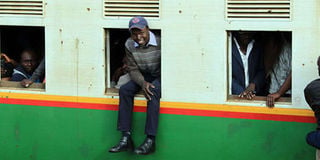Why we are buying diesel train cars for city

A Nairobi Commuter Rail Service train. The Kenya Railways Corporation plans to increase the number of commuters using trains. PHOTO | FILE | NATION MEDIA GROUP
What you need to know:
- Besides the economic benefits, the project will also provide dependable transport services, allowing residents of Nairobi to commute reliably.
- It will also create new opportunities for employment and housing, including to low income residents of Nairobi.
In a world where businesses continue to adapt to changing times, commuter rail has become an integrated part of transport networks in most countries.
Besides enabling urban expansion, these heavy rail systems have far-reaching economic ramifications as commuters move easily from one point to another.
In order to improve customer experience, major cities like London, New York and Paris use these services to connect with more compact systems, like metro and light rail networks.
The world over, governments’ policy of increasing capacity is directly addressing many of the problems that commuters are experiencing. With these global developments, Kenya cannot afford to be left behind.
In line with its strategic plan (2017-2022) on moving passengers, the Kenya Railways Corporation is in the process of complying with a Cabinet decision to acquire modern and efficient refurbished Diesel Multiple Units (DMUs) for use in the Nairobi Commuter Rail (NCR).
REDUCE TRAFFIC
Through funding from the World Bank, KRC undertook a study on the Commuter Rail Masterplan within Nairobi Metropolitan region. The findings of the report informed the Cabinet decision.
The NCR is a project that aims to modernise and expand underutilised railway transport infrastructure facilities within Nairobi to attract passenger traffic from the roads, thus reducing congestion and creating an efficient and affordable mass rapid transit transport system for the city.
It will also integrate rail transport with other modes of transport, namely road and air. This is also in tandem with the ongoing government efforts to decongest the Nairobi CBD.
The project’s objectives are to modernise approximately 150km of track and infrastructure on four major routes radiating from the CBD, introduce modern rolling stock, develop a new 6.5km railway line to Jomo Kenyatta International Airport and provide safe, reliable and affordable services.
BENEFITS
The NCR intends to increase the number of train commuter users from the current 300,000 to three million a month.
Being a public-private partnership, the project will ensure attractive returns on investment. Key project drivers include the fact that Nairobi is the largest city in Kenya and a major transit point in East Africa, with the number of daily commuters estimated at three million people per day out of the seven million Kenyans who come to the city daily.
Besides the economic benefits, the project will also provide dependable transport services, allowing residents of Nairobi to commute reliably.
It will also create new opportunities for employment and housing, including to low income residents of Nairobi.
The project has already undergone a feasibility study defining the scope, technical details and development structure, and is now at implementation stage.
EFFICIENT
The project will be developed in three phases. It is noteworthy that the Cabinet directed purchase of 11 DMUs, which are being procured through a government-to-government arrangement.
The timing will be subject to the procurement lead times and other logistical issues. The benefits of DMUs cannot be overstated.
The DMUs are double train cars but can be marshalled to have triple units or better still, marshal double/triple train units as dictated by the demand based on passenger numbers.
A Double Train Car Unit can ferry 300 passengers (seated and standing). A triple unit would transport 450 passengers while marshalling two DMU units would double the numbers.
SAFETY
The best practices surveyed in World Cities Best Practices in Transportation are divided into four categories: sustainable modes, roadway drainage and maintenance, information technologies, and infrastructure enhancements.
Each corresponds to a major transportation challenge that the city currently faces.
Therefore, to ensure value for money and smooth running of the NCR, the corporation will adopt global best practices to ensure Kenya conforms to safety standards.
The writer is the Acting Managing Director, Kenya Railways Corporation





